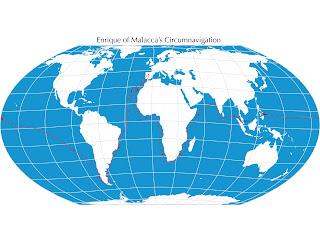 |
| Ptolemy world map created by Lord Nicolas the German in 1482. |
It wasn’t Columbus or Magellan who proved the world was round. The flat Earth notion we hear about today was a medieval phenomenon. By 500 BCE the Greeks had established that the planet was a sphere, and in time estimated its size with surprising accuracy.
In the third century BCE the Greek mathematician Eratosthenes found a simple way of estimating the world’s circumference, measuring the noontime altitude of the sun at two locations. He calculated that the earth was about 40,000 kilometers (24,800 miles) in circumference; today that measurement is put at 40,096 kilometers (24,901 miles). Eratosthenes was that close.
While the ancient Greeks mastered the geometry needed to measure the Earth, they didn’t travel or trade far enough to master its geography. Still, their understanding of the globe provided considerable detail for Renaissance geographers and explorers to start with.
Ptolemy world map
 |
| Mid-15th century Florentine Ptolemy map. |
The Ptolemy (tä-lə-mē) world map shows the world as it was known in the Greco-Roman world in the second century CE. These maps were created based on descriptions in Claudius Ptolemy’s book Geography, written about 150 CE. No original maps from the book itself have ever been discovered.
Claudius Ptolemy (Latin: Claudius Ptolemaeus) (c. 100 CE — c. 170 CE) was a Greek astronomer, mathematician, and geographer who lived in Alexandria during the 2nd century CE.
Little is known about Ptolemy beyond his writings, works that have given him a prominent place in the history of all three fields.
His work Geographia (Geōgraphikē hyphēgēsis, Guide to Geography) gives us a picture of the Greco-Roman understanding of the world. The book lists the locations of 8,000 places known at the time. The knowledge was lost to the West until around 1300. In 1406 it was translated into Latin and numerous manuscripts were created, many of them containing maps based on knowledge from the book. No original maps created by Ptolemy have been discovered.
 |
| Detail of East and Southeast Asia |
Versions of the map created a thousand years after Ptolemy’s death gave Renaissance geographers a starting point. The maps extend from the Shetland Islands in the north to sources of the Nile in the south, and from the Canary Islands in the west to China in the east. The world centers on the Mediterranean Sea and the Indian Ocean, the latter a closed-in sea to the south. To the west of Europe is the long-mysterious ocean sea and the Ptolemy map's end. The book described a large world map along with twenty-six regional maps.
Ptolemy’s work introduced essential map-making concepts including longitudes and latitudes for the places listed, which made it possible to re-create the maps. Parallels and meridians were in use by Ptolemy's day, but they didn't show the Earth's curved surface. Ptolemy's solution was to put meridians at five-degree intervals along the equator and have them merger at the North Pole.
Ptolemy’s idea of having a global coordinate system revolutionized mapmaking in Renaissance Europe.
 |
| A 1478 version. |
.png) |
| Fries, Lorenz, approximately 1490-1531. |
Images:
1. Lord Nicolas the German (Donnus Nicholas Germanus), cartographerJohann the Blockcutter of Armsheim (Johannes Schnitzer or Johannes de Armssheim), engraver PtolemyJacobus Angelus, translator, Public domain, via Wikimedia Commons.
2. By Credited to Francesco di Antonio del Chierico - Ptolemy's Geography (Harleian MS 7182, ff 58–59), Public Domain, Wikimedia Commons.
3. Public Domain, https://commons.wikimedia.org/w/index.php?curid=292974.
4. Ptolemy, Active 2nd Century. World map by Ptolemy. 1478. Photograph. https://www.loc.gov/item/2006675889/.
By John Sailors
Enrique's Voyage, updated from 9/20/22 3:05 PM.
(C) 2022, by John Sailors.


